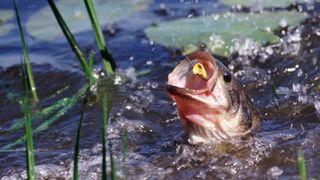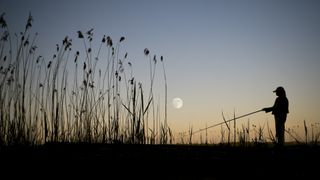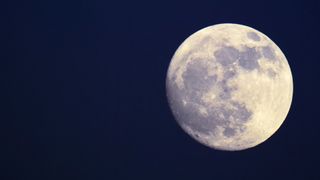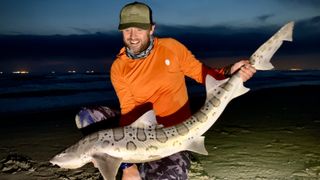Best fishing times: when is the best time to go fishing for maximum success
Working out the best fishing times will have a dramatic impact on your catches. Here's everything you need to know to identify those peak times to hit the water

Knowing how to choose the best times to go fishing is one of the keys to angling success, like knowing how to choose fishing bait and tackle. It’s easy to miss the action if you don’t know a few basic rules around identifying peak feeding times and days to hit the water, so timing should be a key consideration when you start to plan a fishing trip.
We’ve all had those slow fishing days when nothing seems to be interested. It’s boring and disheartening, especially if you’re just starting out in the sport. But replacing those dull sessions with red-letter-days can be easy if you take a bit of time to work out the best days, times and seasons to go fishing.
By the time you finish reading this guide, you'll be aware of all the key factors a professional guide uses to plan his fishing trips and you'll be well–equipped to better identify when to go fishing.
Best fishing times: the best weather to go fishing
One of the main factors influencing immediate feeding behaviour for many species are the current and incoming weather conditions. This is because weather such as sunshine, rain, waves, current and wind influence the temperature, visibility and oxygen levels in the water, which in turn impact how the fish feeds, particularly in freshwater. If it’s cold and still, it’s unlikely that most species will eat freely, instead choosing to save energy and lay low.
However, if the weather is causing the water to become warmer and more oxygenated – a warm southerly wind hits, for example – lots of species like carp, bass and catfish will become active and more catchable. There are lots of reasons for this, one of the main ones being that small creatures like insects and bait fish, which are food items for many species, also become more active in these conditions, causing a feeding frenzy.
Some species, however, favour cold water and species like some flatfish, trout, perch, pike, surf perch, tuna species and cod are usually fished for in cold water or even through ice. Learning what water temperature your target species and their food prefers is another part of knowing the best times to fish.
This relationship between food items and weather conditions is an important one to consider when assessing the best fishing times. If it’s likely the food items your target species eats are active, it’s likely the fishing will be good too. Think about an insect hatching on a trout stream and how that triggers a feeding response. What and when would be the equivalent feeding event at your local water?
Advnture Newsletter
All the latest inspiration, tips and guides to help you plan your next Advnture!
Many people will also purposely fish when they know a weather front is incoming, or in low pressure conditions. Some believe the fish can sense when bad weather is approaching and will feed with this in mind, others believe that low pressure conditions make it easier for some species to be caught as it affects their swim bladder and body in such a way that it becomes easier for them to hunt and find food. And easier to find your bait, too. The old myth of the fishing being good when it’s raining is also likely due to the low pressure conditions often associated with rainfall.
In reality, it’s likely lots of these weather factors play a part in triggering fish to feed and get caught, so working out which ones impact your target species the most is a good way to dial in your next fishing session. You’ll know that when these factors start to fall in your favour – a warm wind and sun on a day you plan to fish a lake where you know the bass and catfish become more active in these warmer conditions, for example – it's the best time to plan a fishing trip.
Best fishing times: the best times of day to go fishing

Undoubtedly, many fish feed the hardest at dawn or dusk – a period often referred to as “bite time” by those in the know. There are a few reasons for the start and end of the day ranking among the best fishing times.
The first is that changes in light conditions often trigger an insect hatch, baitfish activity, plankton bloom or similar, which in turn stirs the interest of the fish as they have an easy meal option. Thus, they will have developed behaviours around hunting for food at these times. This might be a trout coming into shallow water to ambush hatching insect larvae, a muskie hunting basking baitfish, a flounder coming into an estuary to feed, a shark stalking a mackerel shoal, shrimps coming to the surface to feed on plankton or a catfish moving upriver to locate food.
The low light conditions (sometimes known as “grey light”) also make it harder for the fish to see line, hooks, swivels, sinkers, bobbers and boats – all of which might spook a fish from taking your bait or lure in bright daylight. This is a big factor in your favour.
Some species, like certain catfish, rays, eels and sharks, feed better at night as they hold an advantage of their prey in darkness. With their ability to sense tiny amounts of movement and scent in the water, they can locate bait fish easily and help themselves to an easy meal under the cover of night. Others rely on daylight to hunt and feed little at night. Again, researching the feeding behaviour of your desired species will really help your catches.
In general, around dawn or dusk will nearly always be the best fishing time for a range of species and making the effort to time your session around these peak fishing periods is nearly always worth it.
Best fishing times: the best moon cycles to go fishing

The moon impacts both freshwater and saltwater ecosystems, which in turn affects how good the fishing is at any given time, especially in tidal ocean environments.
In general, there’s been a lot written about solunar theory and why the moon matters when it comes to the best fishing times, but we’ll sum up what you need to know to save you a few thousand hours reading.
A new moon, when no or very little moon is visible, has long been a favoured time to fish, along with a full moon. Research and records show that fish activity and catches during these periods, and in particular the days leading up to the new or full moon, are excellent, making this time of the lunar cycle one of the best fishing times.
On a daily basis, the gravitational pull of the moon impacts the earth’s ecosystem and oceans in such a way that animals and fish become more active when it’s in certain positions; chiefly overhead and underfoot. Think of the moon orbiting the earth and where you stand on the planet; when the moon’s orbit (and gravitational influence) takes it directly over where you’re fishing, the moon is overhead. The opposite position is underfoot.
An hour or two either side of moon set and rise, like sunset and sunrise, are also very good bets for lots of species and big bass, carp, shark and catfish anglers are just one group to put a lot of credence behind these peak periods.
Various apps and calendars will help identify these peak moon cycles and these offer some moon set and rise times, too. Have a look on your smartphone’s app store for many free or cheap options that will give you months worth of moon set, rise, overhead and underfoot times, often correlated with factors like tides and sun movements to give guidance on peak fishing times.
But, in general, when the moon is in one of these favourable positions and cycles, and when this favourable position coincides with dawn or dusk, that’s going to be amongst the best day and time to plan a fishing trip.
Learn more in our guide to how to go night fishing.
Best fishing times: The best tides for saltwater (surf, pier, kayak and boat) fishing
The moon also directly impacts the tidal cycle in saltwater, which drives a lot of the feeding behaviours of animals in this environment. The gravitational pull of the moon causes the earth’s oceans to shift in a way that we recognise as tides, with the size and timing of the tidal cycle relative to the moon’s position and distance from earth.
A full or new moon with an orbit closest to the earth, which occurs at various times of the year, results in the biggest tidal movements of the lunar year. These are called King Tides. There are also big tidal cycles during Harvest Moons, Worm Moons and Wolf Moons, which are all just names for a full moon at various times of the year. A new moon also results in larger-than-usual tides with the moon's elliptical orbit exerting more or less force on the earth's water depending on how far away it is at any given time.
This tidal water movement drives much of the behaviour of many saltwater food items; bait fish, crabs, crustaceans, worms, sandfleas, plankton etc. For example, shoals of baitfish will come into shallower water during these larger tidal cycles looking for food items, with predatory fish following them for an easy meal. Crabs and prawns will leave their rocky homes to seek food and become dinner themselves. Sandworms will use the high tide periods when water is running over their burrow to stick their head out and grab prey, making them vulnerable to attack. Fish know this and behave accordingly to make the most of the opportunity. You should too.
Information on tides is easy to find via websites, apps or paper calendars and the size and timing of the highs and lows vary depending on where you live and time of year. Get into the habit of checking these regularly and recognising when the tidal and moon cycle is favourable for fishing every week or two.
Peak times in each tide cycle are often when then water is moving the most, which is a time many fish use to find food and move, and at slack times when the tide is switching between outgoing and incoming, and vice versa. But different species like different states of tide, so pay attention to what you catch and when for clues.
So, for any sort of saltwater fishing, the days leading up to and including the larger tidal cycles – especially those around the new and full moons – are your go–to options for the best beach and boat fishing days. If you can swing it to fish during this favourable moon and tide cycle over dawn or dusk, focusing on high tide times, when the water temperature is favorable for your target species, then even more prey and predators will be active and catchable.
Planning a fishing session on a day with a flatter tidal swing, less water moving, less favourable moon cycles, outside of dawn and dusk, or outside of the peak periods within that day’s tide, is likely to result in less action.
Best fishing times: choosing the best seasons to go fishing

Every fish has their peak season – when conditions favour catchable behaviour in your local area. This is such a wide subject that it’s impossible to cover in one article but we'll cover some general rules to apply.
Think about the huge range of species and their seasonality; from salmon migrating in the Pacific Northwest and mullet runs in Florida, to spring insect hatches in a Midwest trout stream or an ice fisherman in North Dakota catching perch. Each has their own peak season and periods when they’re not as active.
Working out what specific fish you want to catch, or what species are common to your home waters, will allow you to identify their peak seasons and any adjustments you need to make to your fishing trip timing. Keeping records of time, day, conditions, catches, water temperatures and notes will help confirm this.
If you know your local pond or beach spot has lots of species that respond well to warm water temperatures, for example, you’ll want to fish in the summer months. Maybe a deeper lake or reservoir holds warmer water in the winter and is a go-to option for cold weather catfish action, or a grayling–stocked lake offers winter takers as they don't mind cold water.
Many anglers follow the water temperatures closely and know that certain temperatures ranges are great for certain species. It’s up to you to research their preferred temperatures, monthly temperature averages, the best fishing seasons – then gain experience and make a play based on what you know is biting.
Best fishing times: Working out your own fishing calendar
It may seem like you need to consider a bewildering number of factors in working out the best fishing times, but as you become experienced it’ll make more sense. Think of it like a puzzle with a few missing pieces; as you learn more about your quarry, where they live, what they eat, what water temperatures they like and their general preferences, you can fill in those gaps in the puzzle and time your fishing trips for maximum success.
Build on this knowledge and very soon you’ll be able to predict peak fishing days and times well in advance. You'll then be able to plan on obtaining bait and hitting the water at exactly the right time, now you've worked out the best times to go fishing for your area and target species.
An obsessed fisherman since childhood, Ben’s career in fishing has taken him from working as a magazine writer and editor to running his own guiding business in California, where he targets salt and freshwater fish. Ben has decades of experience in selecting the right tackle and honing the best tactics to target all sorts of species, from surf sharks to freshwater catfish, and loves sharing this knowledge. His favorite fishing moments usually involve helping clients catch the fish of a lifetime – and not getting eaten by great white sharks while out on his kayak.
Most Popular
